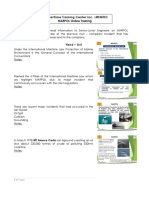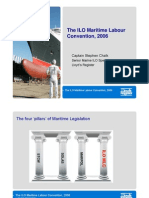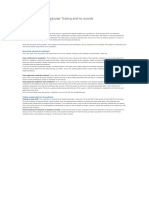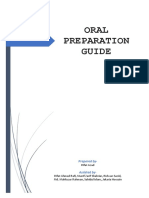Marpol Annex 1
Marpol Annex 1
Uploaded by
Μανος ΦωτοπουλοςCopyright:
Available Formats
Marpol Annex 1
Marpol Annex 1
Uploaded by
Μανος ΦωτοπουλοςOriginal Description:
Copyright
Available Formats
Share this document
Did you find this document useful?
Is this content inappropriate?
Copyright:
Available Formats
Marpol Annex 1
Marpol Annex 1
Uploaded by
Μανος ΦωτοπουλοςCopyright:
Available Formats
Marpol Annex 1 -Regulations for preventing oil pollution from
ships
To prevent pollution of the sea and the consequent destruction and damage to life
in it and along its shores, extensive international legislation exists, and some
nations enforce far-reaching and strict laws. Attention is drawn to national laws in
the appropriate volumes of Admiralty Sailing Directions.
Actual or probable, discharges of oil or noxious substances, or sightings of
pollution should be reported to the coastal authorities.
Specific instructions on reporting, where known, are given in Admiralty List of
Radio Signals Volume 1.
MARPOL Annex I (Oil) entered into force on 2nd October 1983. It contains
regulations for the prevention of pollution by oil. The United Kingdom domestic
legislation to implement this Annex was the Merchant Shipping (Prevention of Oil
Pollution) Regulations 1983.
Discharging of Oil: The regulations govern the discharges, except for clean or
segregated ballast, from all ships. They require inter alia all ships to be fitted with
pollution prevention equipment to comply with the stringent discharge
regulations.
Discharge into the sea of oil or oily mixtures, as defined in an Appendix to the
Convention, is prohibited by the regulations of Annex I except when all the
following conditions are satisfied.
From the machinery space bilges of all ships, except from those of tankers where
the discharge is mixed with oil cargo residue:
•The ship is not within a Special Area;
•The ship is more than 12nautical miles from the nearest land;
•The ship is en route;
•The oil content of the effluent is less than 15 parts per million. And;
•The ship has in operation an oil discharge monitoring and control system,
oily-water separating equipment, oil filtering system or other installation
required by this Annex.
These restrictions do not apply to discharges of oily mixture which without
dilution have an oil content not exceeding 15ppm.
From the cargo area of an oil tanker (discharges from cargo tanks, including
cargo pump rooms; and from machinery space bilges mixed with cargo oil
residue):
•The tanker is not within a Special Area;
•The tanker is more than 50nautical miles from the nearest land;
•The tanker is proceeding en route;
•The instantaneous rate of discharge of oil content does not exceed 30litres
per nautical mile;
•The total quantity of oil discharged into the sea does not exceed for
existing tankers 1/15000 of the total quantity of the particular cargo of
which the residue formed a part, and for new tankers (as defined in the
Annex) 1/30000 of the total quantity of the particular cargo of which the
residue formed a part; and
•The tanker has in operation, except where provided for in the Annex, an oil
discharge monitoring and control system and a slop tank arrangement.
Special and Particularly Sensitive Sea Areas. Annex I applies to all such
areas.
Shipboard Oil Pollution Emergency Plans (SOPEP): Regulation26 of Annex1
to MARPOL 73/78 requires every oil tanker of 150grt and above and every other
vessel of 400grt and above, to carry on board a SOPEP approved by the vessel’s
flag administration. Regulation26 came into force on 4 April 1995 for all existing
vessels.
IMO has produced guidelines, as IMO Resolution MEPC 54(32), for the
development of SOPEPs. This regulation also applies to offshore installations
engaged in gas and oil production, seaports and oil terminals.
Source: http://shipsbusiness.com/causes-of-pollution.html
You might also like
- Annex II SummaryDocument10 pagesAnnex II Summarysukhjit78No ratings yet
- Code of Safe Working Practices for Merchant Seafarers: Consolidated edition (incorporating amendments 1-6)From EverandCode of Safe Working Practices for Merchant Seafarers: Consolidated edition (incorporating amendments 1-6)No ratings yet
- Emergency Engine Operation PDFDocument4 pagesEmergency Engine Operation PDFAnakin SkywalkerNo ratings yet
- Marine Environmental Protection QADocument12 pagesMarine Environmental Protection QAPrasathNo ratings yet
- MARPOL Online Training 05.04.2020 PDFDocument11 pagesMARPOL Online Training 05.04.2020 PDFRen Mark Zuniega100% (1)
- Marpol IdiotDocument52 pagesMarpol IdiotKeshav Shahi100% (1)
- MarpolDocument3 pagesMarpolAbu NawshadNo ratings yet
- MARPOL 1 To 6Document9 pagesMARPOL 1 To 6Jaycel Custodio100% (1)
- Code of Safe Working Practices for Merchant Seafarers Consolidated 2015 edition, including amendments 1-7From EverandCode of Safe Working Practices for Merchant Seafarers Consolidated 2015 edition, including amendments 1-7No ratings yet
- Annex 1 Reg 15 Control of Discharge of OilDocument2 pagesAnnex 1 Reg 15 Control of Discharge of OilsibinmgNo ratings yet
- EGBDocument5 pagesEGBSwarg VibhaNo ratings yet
- 1245 Guidelines For Damage Control PlansDocument4 pages1245 Guidelines For Damage Control PlansVarun Patni100% (1)
- Crude Oil Washing 2Document8 pagesCrude Oil Washing 2Subir BairagiNo ratings yet
- MarPol Annex VI Reg 16-18 PresentationDocument48 pagesMarPol Annex VI Reg 16-18 PresentationZtik PeraltaNo ratings yet
- Revised MARPOL Annex VDocument6 pagesRevised MARPOL Annex VDiana MoralesNo ratings yet
- CLC BunkerDocument10 pagesCLC BunkerParthiban NagarajanNo ratings yet
- Oil Record Book: Commonwealth of DominicaDocument75 pagesOil Record Book: Commonwealth of DominicaSandeep MalakarNo ratings yet
- MARPOL Annex V: Regulations For The Prevention of Pollution by Garbage From Ships (New Amendments)Document4 pagesMARPOL Annex V: Regulations For The Prevention of Pollution by Garbage From Ships (New Amendments)Orlando QuevedoNo ratings yet
- Steering Gear RegulationsDocument2 pagesSteering Gear Regulationsaadarsh kumar100% (2)
- LSA FFA Regulations-1Document19 pagesLSA FFA Regulations-1Harish Chander100% (1)
- Statutory and Mandatory CertificatesDocument14 pagesStatutory and Mandatory CertificatesGAMMA FACULTY100% (1)
- Marpol Annex 6Document11 pagesMarpol Annex 6tripuraridheerajNo ratings yet
- Marpol Annex VDocument3 pagesMarpol Annex VJulio Chavez DiazNo ratings yet
- 07 UNCLOS Note To IMEI Class 1 StudentsDocument4 pages07 UNCLOS Note To IMEI Class 1 StudentsNishanth NishNo ratings yet
- IMO Special Areas Under MARPOLDocument2 pagesIMO Special Areas Under MARPOLRavi Viknesh100% (1)
- The ILO Maritime Labour Convention, 2006: Captain Stephen ChalkDocument35 pagesThe ILO Maritime Labour Convention, 2006: Captain Stephen Chalkvic2r03100% (1)
- Oil Record Book Cum Se Completeaza Corect 15.10.2018Document29 pagesOil Record Book Cum Se Completeaza Corect 15.10.2018Popa VasileNo ratings yet
- Cargo Oil Pump Tanker VesselsDocument8 pagesCargo Oil Pump Tanker VesselsŘhýđm Šâűřābh100% (1)
- Marine Cargo Operations MCAO1010 Course Notes Tankers - Cargo Equipment (Basic)Document12 pagesMarine Cargo Operations MCAO1010 Course Notes Tankers - Cargo Equipment (Basic)sukhjit78No ratings yet
- Oil Record BookDocument12 pagesOil Record BookNorman Sasongko100% (2)
- An Oily Water SeparatorDocument3 pagesAn Oily Water SeparatorMin Soe100% (2)
- Loadicator TestsDocument1 pageLoadicator TestsPanagiotis MouzenidisNo ratings yet
- MEPC.1-Circ.736-Rev.2 - Guidance For The Recording of Operations in The Oil Record Book Part I - Machinery Space Operations... (Secretariat)Document12 pagesMEPC.1-Circ.736-Rev.2 - Guidance For The Recording of Operations in The Oil Record Book Part I - Machinery Space Operations... (Secretariat)Krzysztofeles100% (2)
- Load Lines and Draught MarksDocument9 pagesLoad Lines and Draught MarksEco Jiko100% (1)
- Battery Room Ventilationa and Proper UpkeepingDocument2 pagesBattery Room Ventilationa and Proper Upkeepingdassi99No ratings yet
- Anti Fouling System ConventionDocument27 pagesAnti Fouling System ConventionSheshraj Vernekar100% (2)
- Steering Control SystemsDocument23 pagesSteering Control Systemsdonato del rosario100% (1)
- Rest Hours STCW & MLCDocument2 pagesRest Hours STCW & MLCsameerNo ratings yet
- Nodular Cast Iron, and A Ram. Each Pair of Cylinders Is Tied Together Axially by A Guide Bar and Adjacent Cylinders AreDocument10 pagesNodular Cast Iron, and A Ram. Each Pair of Cylinders Is Tied Together Axially by A Guide Bar and Adjacent Cylinders AreKr Manu100% (2)
- LR National Ballast Water Management Requirements 09 2016Document44 pagesLR National Ballast Water Management Requirements 09 2016Btwins123No ratings yet
- Primary and Secondary Means of Venting On TankersDocument19 pagesPrimary and Secondary Means of Venting On TankersFlexi100% (1)
- D2 Bilge, Ballast SystemsDocument10 pagesD2 Bilge, Ballast SystemsGica Si Popescu100% (1)
- Understanding Conventions, Protocols & Amendments: International Maritime Organization (IMO)Document3 pagesUnderstanding Conventions, Protocols & Amendments: International Maritime Organization (IMO)sbdmanNo ratings yet
- Chief Mates Orals Syllabus MMD DG SHIPPING INDIADocument3 pagesChief Mates Orals Syllabus MMD DG SHIPPING INDIAGurjit SinghNo ratings yet
- IMO Grain Code Stability RequirementsDocument2 pagesIMO Grain Code Stability RequirementsRakesh EdekkadNo ratings yet
- Steering Gear Systems On Ships NotesDocument13 pagesSteering Gear Systems On Ships NotesRoche Gallardo TampilNo ratings yet
- Oral-Preparation-Guide (Rifat Azad-Bma 49) PDFDocument105 pagesOral-Preparation-Guide (Rifat Azad-Bma 49) PDFTarek Aziz100% (2)
- 14.incineration12 02 08Document15 pages14.incineration12 02 08nilakhan456790100% (1)
- Type of Gas CarriersDocument3 pagesType of Gas CarriersArun Iyer100% (1)
- Convention On Limitation of Liability For Maritime ClaimsDocument15 pagesConvention On Limitation of Liability For Maritime ClaimsRozaline Jacquet-BalianNo ratings yet
- US Environmental Protection Agency National Pollution Discharge Elimination System Vessel General PermitDocument37 pagesUS Environmental Protection Agency National Pollution Discharge Elimination System Vessel General PermitHarbinder SinghNo ratings yet
- LSFOchangeovercalculator tcm155-175156Document23 pagesLSFOchangeovercalculator tcm155-175156George PonparauNo ratings yet
- Orb Criminal Cases PDFDocument27 pagesOrb Criminal Cases PDFvivek100% (1)
- Fobas Bunker Sample ResultDocument6 pagesFobas Bunker Sample ResultRiskyMaulanaNo ratings yet
- IntertankoDocument45 pagesIntertankoBrijendra Kumar Srivastava100% (1)
- Marpol Annex Vi: - Regulations For The Prevention of Air Pollution From Ships Now in Force (19 March, 2005)Document31 pagesMarpol Annex Vi: - Regulations For The Prevention of Air Pollution From Ships Now in Force (19 March, 2005)arun100% (1)
- LSACODEDocument44 pagesLSACODEsidadams2No ratings yet
- 9 Oil Pollution Act of 1990Document6 pages9 Oil Pollution Act of 1990Ur Loafer MarinerNo ratings yet



























































